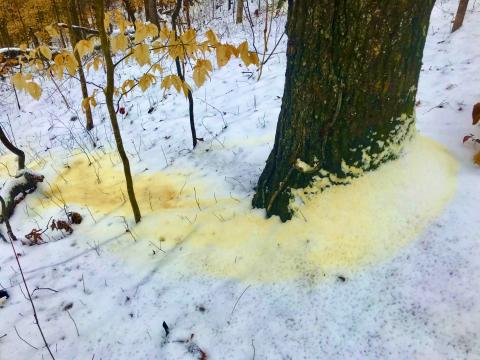Snow Colors Beyond Yellow
By Steve Roark
Volunteer Interpreter, Cumberland Gap National Park
Snow is normally a dazzling, at times blinding white and we all enjoy the good snow that sticks to all the trees and is a thing of beauty. Snow strangely enough can be other colors at times, the most common being yellow where a dog peed on a tree or a juvenile male human peed his initials in the back yard. There are still other colors of snow that occur on the planet and so here is a rundown of some of them.
Yellow to Brown Snow: Urine is not the only coloring agent of yellow snow. Some trees, especially oaks, have a lot of tannins in the bark, which are organic compounds that are acidic and protect the tree from bacterial and fungal infection. Wet snow on the tree can leach these tannins out of the bark, which run down to the base of the tree, where it turns the snow yellow. It requires a lot of moisture to occur, like when it rains first and then turns to snow. I saw it only one time and it looked like all the oaks in the woods had been peed on by elephants.
Blue Snow: I have seen this color several times. Under low light conditions, such a really cloudy day or in dark shadows, snow will absorb all of the color wavelengths of light but not all of the blue, so the snow looks bluish. When I’ve seen this everything has a blue-gray tint to it, snow, trees, the sky, everything. The clouds that provide the right light level to do this must be snow clouds, because it always seems to snow after I see the blue snow phenomena.
Watermelon Snow: this snow comes in shades of red and green, hence the name. This occurs in alpine and polar regions of the planet and are caused by algae and sometimes bacteria. The green color comes from chlorophyll in the algae, while the red comes from astaxanthin, a red pigmented chemical compound also produced by algae. This same red chemical compound also turns flamingos pink (they are normally light gray) when they eat a lot of algae with that pigment. Algal pigments can also turn snow red, orange, or brown.
Gray and Black Snow: this is just plain ol’ dirty snow, coming from the dust of a volcano, city soot, ash, or vehicle exhaust.
The timeworn joke of “don’t eat the yellow snow” holds true for other snow colors as well. Tree bark tannins are acidic, and the algae that produce a lot of the snow colors can release some unhealthy toxins. So stick with white snow for eating or making snow cream, preferably fresh fallen, but if not scrape away the top layer before collecting. Oh, and just so I’ve covered all the bases, urine is yellow because it contains the pigment urobilin, which comes from the breakdown of hemoglobin from old red blood cells, so there you go. Information for this article came from Science Notes.org.
- Log in to post comments
